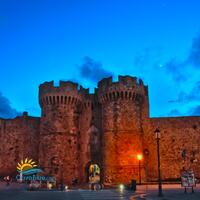
Rhodes
The Island of the Knights
Rhodes is the largest island in the Dodecanese with a rich history and is one of the top and most secure destinations in the world. It is not by chance that the flagship of Greek tourism, which almost every year goes beyond the limits of tourist traffic on the island.
The fact that it is consistently ranked fourth in arrivals at national level, as well as the fact that visitors arriving on the island with a cruise ship numbering in the tens of thousands per year, prove that Rhodes is an internationally recognized tourist destination, with of particular importance to the Greek economy.
Rhodes has countless attractions and many beautiful beaches, almost all of which are organized. The quietest beaches are in the south of the island, beyond Lindos.

| Feels like | 19.47 ℃ |
| Humidity | 83 % |
| Wind | 2bf WSW |
Live View
Rhodes is the largest island of the Dodecanese and is located in the southeast Aegean. It has an area of 1,400,684 km2 and its highest point is the peak of Mount Attaviros, at a height of 1,215 meters. According to the 2011 census, the island's population is 115,490, making Rhodes the third most populous Greek island. At the northeast end of the island is its capital, the city of Rhodes, with a population of about 55,000 and it is the largest settlement of the island.
About 12 km southwest of the city is Rhodes State Airport "Diagoras", which is the main gateway for visitors to the island.
Within the city limits of Rhodes lies the Medieval City of Rhodes or the Old Town, as the locals call it, one of the best preserved medieval cities in the world, recognized since 1988 as a UNESCO World Heritage Site. Within the walls of the Old Town are remarkable monuments from the Byzantine era, the Turkish occupation and the Italian occupation and most notably the Palace of the Grand Master.
During your visit to the villages, beaches and sights of southern Rhodes, you may even come across deer, the largest mammals living freely on the island, the world-known Platonia (Dama dama). Platonia are part of Rhodes' natural wealth and are beautiful, small deer with expressively large eyes and perfect body proportions.
The rich history of Rhodes is pervasive in every corner of the island, as every conqueror that passed has left its strong mark. The island was particularly prosperous in the 4th century. BC, when the famous Colossus rose, a work by Lindy Haris, a disciple of Lysipus. After the devastating earthquake of 155 AD The Persians, Arabs, Saracens, and Seljuks settled on the island, and in 1309 the Knights of St. John arrived, renovating the castle with a unique fortification in Europe. It was their seat until 1522, when it was conquered by the Turks. In 1912 it passed to the Italians and in 1948 it was incorporated with the rest of the Dodecanese into Greek territory.
Today
The city of Rhodes was particularly developed during the last years of the 1990s and the early years of the new century. The municipality went beyond the narrow limits of 1990 and new areas were developed to the southeast, such as Karakonero and lower Rodini. The wider area of the Ascension also experienced significant development, while several areas around the city were merged or annexed to the municipality of Rhodes (Koskinou, Ixia, Saint Apostles). The need for new housing areas, the improvement of the existing road axes of the city, as well as the complete reconstruction along these axes, created the wider urban complex of Rhodes town, consisting of the homonymous municipality and the municipalities of Kallithea and Ialyssos . In these municipalities have established a substantial part of the city's old population and have developed independent neighborhood centers, offering a wide range of shops, helping residents avoid the city center to cater to their daily needs.


















































































